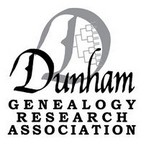|
4. SAMUEL 2 DUNHAM (John 1) born probably in Leiden, Holland in 1623; [1] died in Plymouth, Massachusetts 20 January
1711/2 in 89th year. [2] Samuel married first 29 June 1649 MARTHA (BEAL) (FALLOWAY), [3] daughter of John Beal of Hingham
and widow of William Falloway. [4] She died in Plymouth 26 April 1690. [5] Samuel married second in Plymouth 15 January
1693/4 widow SARAH WATSON. [6]
The early grants of land to Samuel Dunham give an indication of his land holdings and his disposition of them. From the
Records of the Town of Plymouth:
- Vol. 1:48, 27 October 1662; Samuel was among those who “desire meddow in Sampson’s Country.” [7]
- Vol. 1:50, 27 October 1662; “Thirty acres of upland is granted unto Samuel Dunham lying at Warrens Wells on the easterly side therof...” This was low land between South Pond Road and Russell Mills Pond.
- Vol. 1:59, 26 January 1663; “The Town have graunted unto Samuel Dunham and Gyles Rickard, Juni; a parcel of meddow ground commonly called...Southers Marsh, to each of them a like proportion therof, the whole estimated at about twelve acres...”
- Vol. 1:60-61, 21 February 1663; “At this meeting the Towne granted unto Samuel Dunham, Joseph Dunham, Abraham Jackson and Jonathan Pratt to each of them six acres of meddow; lying in a meddow near the lower south meddow.” [8]
- Vol. 1:66, 22 March 1663; description of land on Puncateesett Necke (which was on the Seconnet River, now in Rhode Island) with the owners names include “Samuel Dunham and James Cole, Juni. Lot #25, lott on the north side of the 24th lott and at the west end is bounded with a walnut stake and a walnut bush and extends from the water side to the highway in the middle of the neck.”
The early land transactions of the sons of Deacon John Dunham are interesting because they show a pattern of consolidation of land holdings into a particular area where each of the Dunham sons chose to settle. Portions of these land holdings that were not sold by the second generation, but were passed down to the third generation either by inheritance or by deed of gift give us an indication of the locations where the third generation settled. The following land records illustrate this point.
From MD, Vol. 36 #2, July 1986, p. 163, Samuell Dunham to John Tilson
- “On 2 January 1665, Samuell Dunham of Plymouth sells to John Tilson two parcels of land; ‘my parte of meddow that lyeth in the cove of meddow lately graunted on the easterly side of the lower south meddow, that parte of my meddow lying in the cove bounded on the west and southwest end by the meddow of Joseph Dunham...’, and ‘one acre of meddow...lying in the meddow commonly called (Dotens) meddow bounded on the one side with the meddow of Jonathan Dunham, and on the other side with the meddow of Gabriell Fallowell.’
- Wit. Thomas Southworth”
Ply. Co. LR 3:20, dated 20 May 1684 shows that Samuel conveyed all property to “only son Samuel,” “land at Wellingsly or ye Little Town, garden plot or homestead on which my son’s house now standeth and several other parcels of land.” (Wellingsly was an area on Plymouth Harbor south of the center of the town, later usually called Hobs Hole.)
The Town Meeting of 10 February 1643 made mention of "Goodman Dunhame" who was to help the inhabitants of Wellingsly make a wolf trap. [9] When Samuel Dunham was about 65 years old, he assumed a new position being that of Master of the House of Correction. Records of the Court of General Sessions describe this more fully.
From: Court of General Sessions:
- Vol. 1:199, Court session of 1688, “The court ordered that the prison in Plimouth shall be improved as a house of correction,” and appointed Samuel Dunham, Sr. “to be Master of the House of Correction to Receive and Punish all persons that shall be sent thither.” Dunham was to be paid 20s. for the year “Besides 5 s. For each persons admittance and 4 pence per diem for each persons diet.” Offenders were to pay “for their keeping and punishment” and if unable to pay, “the charge of it shall be born by the County.”
- Vol. 1:222, Court session of Sept. 1692, Samuel Dunham was continued in the office of under marshal and jail keeper. Court allowed his salary for 1 year, £3 “which is to be ½ in money and the other half corn at money price” paid by the county.
Children of Samuel and Martha (Beal) (Falloway) Dunham born in Plymouth: [10]
- 16. i. SARAH-3 DUNHAM, b. 10 Apr. 1650
- ii. twin son, b. 29 Dec. 1651, d.y.
- iii. twin son, b. 29 Dec. 1651, d.y.
- 17. iv. SAMUEL-3 DUNHAM , b. about 1653 [11]
References:
- 1. TGMB p. 602.
- 2. Ibid.; Plymouth VR p. 136.
- 3. Plymouth VR p. 657.
- 4. TGMB p. 602.
- 5. Plymouth VR p. 134.
- 6. Plymouth VR p. 87; 1:7 & 4:1; Torrey p. 234 lists 2nd wife Sarah Watson, m. 15 Jan. 1693/4.
- 7. Records of the Town of Plymouth, Vol. 1 1636-1705, Plymouth 1889, p. 48n ‘Sampson’s Countrey was in the vicinity of Assowampsett Pond in Lakeville.’
- 8. History of Carver, by Henry S. Griffith, 1913; "South medows originally included all of the meadow land on the Weweantic River from Swan Hold to Colchester,. . .Lower South Meadows afterwards applied to the village of Centre Carver. . ."
- 9. Records of the Town of Plymouth, Vol. 1 p. 16.
- 10. Plymouth VR p. 658-9.
- 11. TAG 30:153.
|
![]() Comments to the [Historian]
Comments to the [Historian]
